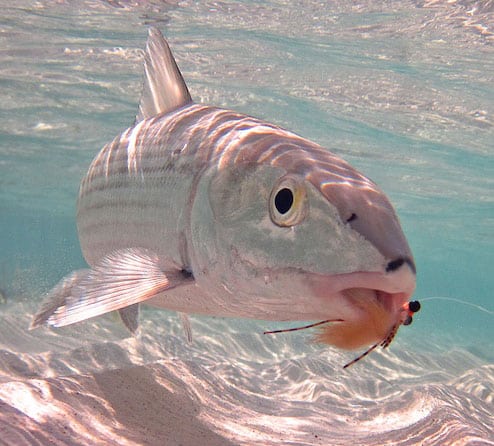
For the Love of Bonefish
I must have been about 14 years old when I first learned of them. My high school fishing partner and I were standing in the schoolyard early one morning before the day was to start and were discussing our favorite subject — fly-fishing.
“Bonefish? What, these things can take 100 yards of backing?” I said to my friend.
When I heard this, it drove me over the edge. I went to the public library and read everything I could about this powerful fish. When I researched the fish, I saw that the all-tackle world record came from the coast of South Africa, about 30 kilometers north of one of the first places I ever cast a fly in the salt. This completely fueled my obsession.
A few years later, after countless hours of trying, I eventually caught a small one in the surf. Now I could officially say I had caught a bonefish. Did it blow my hair back? No. Granted, it was a small fish, but nonetheless, some of the other species in my home waters meant a lot more to me. It would take me another 10 years before I would understand why this fish is so special.
Eat or Be Eaten
For some anglers, bonefishing is a religious experience. I have seen inexperienced anglers stand on a shoal and cast to 8-pound fish lying in 4 feet of water, hooking 30 or more fish in a session. The next thing you know, they are bonefish experts. They can now tell the entire world exactly how to catch a bonefish; they have, after all, just done it with great success. To me, this isn’t bonefishing, and catching them that way doesn’t do the fish justice.
I love bonefish because they are honest. If you do your bit right, they will oblige you and eat the fly. Therein lies the questions: “What is your bit, and how do you do it right?” Bonefish, just like the greater majority of other species we target on fly, are opportunistic feeders. They live in an eat-or-be-eaten environment. If you can present your fly to a bonefish without the fish knowing that you are there, the odds are good that he will eat, irrespective of what it looks like. The single most important thing here is to make sure that you can get the fly in front of the fish so he can see it. Granted, you can’t cast a sailfish fly at them, but if it’s a Golden Knight, Gotcha or Crazy Charlie — if he’ll eat one, he’d more than likely eat the others too.
Body Language
Inexperienced anglers can go out on a dead tide, stand on the edge of a channel and bomb casts into a shoal of 8-pound fish sitting in deep water and catch them cast for cast. Or, later on that same day, I could take a guy who is up for a challenge and show him what makes bonefish fishing so special. In my neck of the woods the biggest bonefish are always the first ones on the flats and the last ones to leave. When conditions are right, they feed for as long as possible. It doesn’t get better than a late-afternoon falling tide. The low, flat light makes it tough to make out their bodies, and all you have to go by are their tails sticking out above the water. This situation also makes the fish calmer than when the sun is 90 degrees on the flats.
When the fish is in 8 inches of water and his back and dorsal fins stick out, his face is close to the sand, which means his cone of vision is very small. So, to get the fly in front of that one single fish means the angler must present the fly with pinpoint accuracy. His body language will tell you once he has seen the fly for the first time. When he eats, you can see it in the way the fish contorts its dorsal fin. Experienced eyes can tell the fish has eaten before the angler has even felt it.
Once hooked, a bonefish will run across the flat leaving a rooster tail of water like a bass boat on competition day. Bonefishing is not about numbers; it’s not even about size — it’s about catching a spooky fish when he is at his most vulnerable and the odds are stacked against you.









